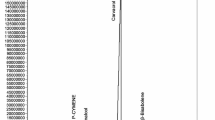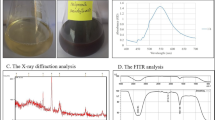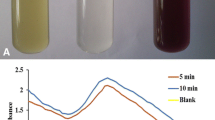Abstract
In this study, simple and green route approach was applied for the synthesis gold nanoparticles (AuNPs) containing an aqueous extract of Cynodon dactylon L. Pers., (C. dactylon). The synthesized AuNPs were characterized using spectral and microscopic analysis. The changes in the color pattern were observed upon synthesis by UV–vis spectrophotometer with a peak of 530 nm. The FT-IR, XRD, SEM, and TEM were used to analyze the crystal nature and morphology of the green synthesized AuNPs. The C. dactylon-loaded AuNPs in different concentrations (0.625–100 μg/ml) were used to assess cytotoxicity activity against MCF-7 cell line and where the IC50 was found to be 31.34 μg/ml by MTT assay. The C. dactylon-AuNPs were significantly increased reactive oxygen species (ROS) generation, DNA fragmentation, and mitochondrial membrane changes observed by dichlorodihydroflurescenin diacetate (DCFH-DA), 4′,6-diamidino-2-phenylindole (DAPI), Rhodamine-123, and acridine orange (AO)/ethidium bromide (EtBr) staining assay. Besides the microbial study revealed that C. dactylon-AuNPs exhibited significant antibacterial activity against clinically isolated pathogenic bacteria such as Enterobacter cloacae, Staphylococus Haemolytics, Staphylococcus petrasii subsp. Pragensis and Bacillus cereus with a zone of inhibition 13, 12, 13 and 12 mm, respectively. It could be concluded that C. dactylon has the ability to be involved in the biosynthesis of AuNPs, and the pharmacological studies proved the promising cytotoxic effect on MCF-7 cell line and pathogenic bacterial species.






Similar content being viewed by others
References
Schwartz-Duval AS, Konopka CJ, Moitra P, Daza EA, Srivastava I, Johnson EV, Kampert TL, Fayn S, Haran A, Dobrucki LW (2020) Intratumoral generation of photothermal gold nanoparticles through a vectorized biomineralization of ionic gold. Nat Commun 11(1):4530. https://doi.org/10.1038/s41467-020-17595-6
Salem SS, Fouda A (2020) Green synthesis of metallic nanoparticles and their prosective biotechnological applications: an overview. Biol Trace Elem Res. https://doi.org/10.1007/s12011-020-02138-3
Jeevanandam J, Barhoum A, Chan YS, Dufresne A, Danquah MK (2018) Review on nanoparticles and nanostructured materials: History, sources, toxicity and regulations. Beilstein J Nanotechnol 9:1050–1074. https://doi.org/10.3762/bjnano.9.98
Elahi N, Kamali M, Baghersad MH (2018) Recent biomedical applications of gold nanoparticles: a review. Talanta 184:537–556. https://doi.org/10.1016/j.talanta.2018.02.088
Patil MP, Kim GD (2020) Gold nanoparticles: Biogenic synthesis and anticancer application. In: Saquib Q, Faisal M, Al-Khedhairy AA, Alatar AA (eds) Green synthesis of nanoparticles: applications and prospects. Springer, Singapore . https://doi.org/10.1007/978-981-15-5179-6_9
Goddard ZR, Marín MJ, Russell DA, Searcey M (2020) Active targeting of gold nanoparticles as cancer therapeutics. Chem Soc Rev 49:8774–8789. https://doi.org/10.1039/D0CS01121E
D’Mello SR, Cruz CN, Chen M-L, Kapoor M, Lee SL, Tyner KM (2017) The evolving landscape of drug products containing nanomaterials in the United States. Nat Nanotechnol 12:523–529. https://doi.org/10.1038/nnano.2017.67
Miele E, Spinelli GP, Mile E, Tomao F, Tomao S (2009) Albumin-bound formulation of paclitaxel (Abraxane® ABI-007) in the treatment of breast cancer. Int J Nanomed 4:99–105. https://doi.org/10.2147/ijn.s3061
Siegel Rebecca L, Kimberly SM, Ahmedin J (2020) Cancer statistics, 2020. CA Cancer J Clin 70:7–30. https://doi.org/10.3322/caac.21590
Ferlay J, Colombet M, Soerjomataram I, Mathers C, Parkin DM, Piñeros M, Znaor A, Bray F (2019) Estimating the global cancer incidence and mortality in 2018: GLOBOCAN sources and methods. Int J Cancer 144(8):1941–1953. https://doi.org/10.1002/ijc.31937
Jung KW, Won YJ, Kong HJ, Lee ES (2019) Cancer statistics in Korea: incidence, mortality, survival, and prevalence in 2016. Cancer Res Treat Off J Korean Cancer Assoc 51(2):417–430. https://doi.org/10.4143/crt.2019.138
Zhao CY, Cheng R, Yang Z, Tian ZM (2018) Nanotechnology for cancer therapy based on chemotherapy. Molecules 23(4):826. https://doi.org/10.3390/molecules23040826
Huang CY, Ju DT, Chang CF, Reddy PM, Velmurugan BK (2017) A review on the effects of current chemotherapy drugs and natural agents in treating non-small cell lung cancer. Biomedicine (Taipei) 7(4):23. https://doi.org/10.1051/bmdcn/2017070423
Elia P, Zach R, Hazan S, Kolusheva S, Ze P, Zeiri Y (2014) Green synthesis of gold nanoparticles using plant extracts as reducing agents. Int J Nanomed 9:4007–4021. https://doi.org/10.2147/IJN.S57343
Dumur F, Guerlin A, Dumas E, Bertin D, Gigmes D, Mayer CR (2011) Controlled spontaneous generation of gold nanoparticles assisted by dual reducing and capping agents. Gold Bull 44:119–137. https://doi.org/10.1007/s13404-011-0018-5
El-Borady OM, Ayat MS, Shabrawy MA, Millet P (2020) Green synthesis of gold nanoparticles using Parsley leaves extract and their applications as an alternative catalytic, antioxidant, anticancer, and antibacterial agents. Adv Powder Tech 31(10):4390–4400. https://doi.org/10.1016/j.apt.2020.09.017
Wang L, Xu J, Yan Y, Liu H, Karunakaran T, Li F (2019) Green synthesis of gold nanoparticles from Scutellaria barbata and its anticancer activity in pancreatic cancer cell (PANC-1). Artif Cells Nanomed Biotechnol 47(1):1617–1627. https://doi.org/10.1080/21691401.2019.1594862
Sun B, Nanjun Hu, Han L, Yanan Pi Yu, Gao KC (2019) Anticancer activity of green synthesised gold nanoparticles from Marsdenia tenacissima inhibits A549 cell proliferation through the apoptotic pathway. Artif Cells Nanomed Biotechnol 47:4012–4019. https://doi.org/10.1080/21691401.2019.1575844
Nischitha R, Vasanthkumari MM, Kumaraswamy BE, Shivanna MB (2020) Antimicrobial and antioxidant activities and chemical profiling of Curvularia tsudae endophytic in Cynodon dactylon (L.) Pers. 3 Biotech 10(7):1–12. https://doi.org/10.1007/s13205-020-02250-0
Albert-Baskar A, Ignacimuthu S (2010) Chemopreventive effect of Cynodon dactylon (L.) Pers. extract against DMH-induced colon carcinogenesis in experimental animals. Exp Toxicol Pathol 62:423–431. https://doi.org/10.1016/j.etp.2009.06.003
Jarald EE, Joshi SB, Jain DC (2008) Antidiabetic activity of aqueous extract and non polysaccharide fraction of Cynodon dactylon Pers. Indian J Exp Biol 46(9):660–667
Singh SK, Kesari AN, Gupta RK, Jaiswal D, Watal G (2007) Assessment of antidiabetic potential of Cynodon dactylon extract in streptozotocin diabetic rats. J Ethnopharmacol 114(2):174–179. https://doi.org/10.1016/j.jep.2007.07.039
Abdullah S, Gobilik J, Chong K (2013) In vitro antimicrobial activity of Cynodon dactylon (L.) Pers. (bermuda) against selected pathogens. Dev Sustain Chem Bioprocess Technol. https://doi.org/10.1007/978-1-4614-6208-8_29
Savadi S, Vazifedoost M, Didar Z, Nematshahi MM, Jahed E (2020) Phytochemical analysis and antimicrobial/antioxidant activity of Cynodon dactylon (L.) Pers. rhizome methanolic extract. J Food Qual. https://doi.org/10.1155/2020/5946541
Golshan A, Hayatdavoudi P, Mousa A, Rad AK, Roshan NM, Abbasnezhad A, Mousavi SM, Pakdel R, Zarei B, Aghaee A (2017) Kidney stone formation and antioxidant effects of Cynodon dactylon decoction in male Wistar rats. Avicenna J Phytomed 7(2):80–190
Singh SK, Rai PK, Mehta S, Singh RK, Watal G (2009) Curative effect of Cynodon dactylon against STZ induced hepatic injury in diabetic rats. Indian J Clin Biochem 24:410–413. https://doi.org/10.1007/s12291-009-0073-3
Karthik D, Ravikumar SJB, Sciences E (2011) A study on the protective effect of Cynodon dactylon leaves extract in diabetic rats. Biomed Environ Sci 24:190–199. https://doi.org/10.3967/0895-3988.2011.02.014
Kowsalya R, Kaliaperumal J, Vaishnavi M, Namasivayam E (2015) Anticancer activity of Cynodon dactylon L. root extract against diethyl nitrosamine induced hepatic carcinoma. South Asian J Cancer 4(2):83–87. https://doi.org/10.4103/2278-330X.155691
Pal D (2008) Evaluation of CNS activities of aerial parts of Cynodon dactylon Pers. in mice. Acta Pol Pharm 65:37–43
Pennacchio M, Jefferson L, Havens K (2010) Uses and abuses of plant-derived smoke: its ethnobotany as hallucinogen, perfume, incense, and medicine. Oxford University Press, Oxford
Vijayakumar S, Vinayagam R, Anand MAV, Venkatachalam K, Saravanakumar K, Wang M-H, Gothandam K, David E (2020) Green synthesis of gold nanoparticle using Eclipta alba and its antidiabetic activities through regulation of Bcl-2 expression in pancreatic cell line. J Drug Deliv Sci Tech. https://doi.org/10.1016/j.jddst.2020.101786
Sharma D, Kanchi S, Bisetty K (2019) Biogenic synthesis of nanoparticles: a review. Arabian J Chem 12(8):3576–3600
Lydia DE, Khusro A, Immanuel P, Esmail GA, Al-Dhabi NA, Arasu MV (2020) Photo-activated synthesis and characterization of gold nanoparticles from Punica granatum L. seed oil: an assessment on antioxidant and anticancer properties for functional yoghurt nutraceuticals. J Photochem Photobiol B Biol. https://doi.org/10.1016/j.jphotobiol.2020.111868
Arunachalam KD, Arun LB, Annamalai SK, Arunachalam AM (2014) Biofunctionalized gold nanoparticles synthesis from Gymnema sylvestre and its preliminary anticancer activity. Int J Pharm Pharm Sci 6:423–430
Isaac R, Sakthivel G, Murthy C (2013) Green synthesis of gold and silver nanoparticles using Averrhoa bilimbi fruit extract. J Nanotechnol 906592:6. https://doi.org/10.1155/2013/906592
Sundeep D, Kumar TV, Rao PS, Ravikumar R, Krishna AG (2017) Green synthesis and characterization of Ag nanoparticles from Mangifera indica leaves for dental restoration and antibacterial applications. Prog Biomater 6:57–66. https://doi.org/10.1007/s40204-017-0067-9
Patil MP, Ngabire D, Thi HHP, Kim M-D, Kim GD (2017) Eco-friendly synthesis of gold nanoparticles and evaluation of their cytotoxic activity on cancer cells. J Clust Sci 28:119–132. https://doi.org/10.1007/s10876-016-1051-6
Patil MP, Bayaraa E, Subedi P, Piad LLA, Tarte NH, Kim GD (2019) Biogenic synthesis, characterization of gold nanoparticles using Lonicera japonica and their anticancer activity on HeLa cells. J Drug Deliv Sci Technol 51:83–90. https://doi.org/10.1016/j.jddst.2019.02.021
Sunderam V, Thiyagarajan D, Lawrence AV, Mohammed SSS, Selvaraj A (2019) In-vitro antimicrobial and anticancer properties of green synthesized gold nanoparticles using Anacardium occidentale leaves extract. Saudi J Biol Sci 26:455–459. https://doi.org/10.1016/j.sjbs.2018.12.001
Sahu N, Soni D, Chandrashekhar B, Sarangi BK, Satpute D, Pandey RA (2013) Synthesis and characterization of silver nanoparticles using Cynodon dactylon leaves and assessment of their antibacterial activity. Bioprocess Biosyst Eng 36:999–1004. https://doi.org/10.1007/s00449-012-0841-y
Meenatchi T, Palanimurugan A, Dhanalakshmi A, Maheshkumar V, Natarajan B (2020) Green synthesis of Cynodon Dactylon capped concentrations on ZnO nanoparticles for antibacterial activity, ROS/ML-DNA treatment and compilation of best controlling microbes by mathematical comparisons. Chem Phys Lett. https://doi.org/10.1016/j.cplett.2020.137429
Xia Q, Huang J, Feng Q, Chen X, Liu X, Li X, Zhang T, Xiao S, Li H, Zhong Z (2019) Size-and cell type-dependent cellular uptake, cytotoxicity and in vivo distribution of gold nanoparticles. Int J Nanomed 14:6957–6970. https://doi.org/10.2147/IJN.S21400
Botha TL, Elemike EE, Horn S, Onwudiwe DC, Giesy JP, Wepener V (2019) Cytotoxicity of Ag, Au and Ag-Au bimetallic nanoparticles prepared using golden rod (Solidago canadensis) plant extract. Sci Rep 9(1):4169. https://doi.org/10.1038/s41598-019-40816-y
Rodríguez-León E, Rodríguez-Vázquez BE, Martínez-Higuera A, Rodríguez-Beas C, Larios-Rodríguez E, Navarro RE, López-Esparza R, Iñiguez-Palomares RA (2019) Synthesis of gold nanoparticles using Mimosa tenuiflora extract, assessments of cytotoxicity, cellular uptake, and catalysis. Nanoscale Res Lett 14:334. https://doi.org/10.1186/s11671-019-3158-9
Sabharwal SS, Schumacker PT (2014) Mitochondrial ROS in cancer: initiators, amplifiers or an Achilles’ heel? Nat Rev Cancer 14(11):709–721. https://doi.org/10.1038/nrc3803
Ly JD, Grubb DR, Lawen A (2003) The mitochondrial membrane potential (Δψ m) in apoptosis; an update. Apoptosis 8(2):115–128. https://doi.org/10.1023/a:1022945107762
Chen Q, Chai Y, Mazumder S, Jiang C, Macklis R, Chisolm G, Almasan A (2003) The late increase in intracellular free radical oxygen species during apoptosis is associated with cytochrome c release, caspase activation, and mitochondrial dysfunction. Cell Death Differ 10(3):323–334. https://doi.org/10.1038/sj.cdd.4401148
Han X, Jiang X, Guo L, Wang Y, Veeraraghavan VP, Krishna Mohan S, Wang Z, Cao D (2019) Anticarcinogenic potential of gold nanoparticles synthesized from Trichosanthes kirilowii in colon cancer cells through the induction of apoptotic pathway. Artif Cells Nanomed Biotechnol 47(1):3577–3584. https://doi.org/10.1080/21691401.2019.1626412
Gupta S, Kass GE, Szegezdi E, Joseph B (2009) The mitochondrial death pathway: a promising therapeutic target in diseases. J Cell Mol Med 13(6):1004–1033. https://doi.org/10.1111/j.1582-4934.2009.00697.x
Wu T, Duan X, Hu C, Wu C, Chen X, Huang J, Liu J, Cui S (2019) Synthesis and characterization of gold nanoparticles from Abies spectabilis extract and its anticancer activity on bladder cancer T24 cells. Artif Cells Nanomed Biotechnol 47(1):512–523. https://doi.org/10.1080/21691401.2018.1560305
Kowsalya E, MosaChristas K, Jaquline CRI, Balashanmugam P, Devasena T (2020) Gold nanoparticles induced apoptosis via oxidative stress and mitochondrial dysfunctions in MCF-7 breast cancer cells. Appl Organomet Chem. https://doi.org/10.1002/aoc.6071
Nagata S (2000) Apoptotic DNA fragmentation. Exp Cell Res 256(1):12–18. https://doi.org/10.1006/excr.2000.4834
Heimann RB, Lehmann HD (2015) Bioceramic coatings for medical implants: trends and techniques. John Wiley & Sons, Hoboken
Krishnaraj C, Muthukumaran P, Ramachandran R, Balakumaran M, Kalaichelvan P (2014) Acalypha indica Linn: biogenic synthesis of silver and gold nanoparticles and their cytotoxic effects against MDA-MB-231, human breast cancer cells. Biotech Rep 4:42–49. https://doi.org/10.1016/j.btre.2014.08.002
Yun Z, Chinnathambi A, Alharbi SA, Jin ZJ (2020) Biosynthesis of gold nanoparticles using Vetex negundo and evaluation of pro-apoptotic effect on human gastric cancer cell lines. J Photochem Photobiol B. https://doi.org/10.1016/j.jphotobiol.2019.111749
Cordani M, Somoza ÁJC, Sciences ML (2019) Targeting autophagy using metallic nanoparticles: a promising strategy for cancer treatment. Cell Mol Life Sci 76(7):1215–1242. https://doi.org/10.1007/s00018-018-2973-y
Uzma M, Sunayana N, Raghavendra VB, Madhu CS, Shanmuganathan R, Brindhadevi K (2020) Biogenic synthesis of gold nanoparticles using Commiphora wightii and their cytotoxic effects on breast cancer cell line (MCF-7). Process Biochem 92:269–276. https://doi.org/10.1016/j.procbio.2020.01.019
Munawer U, Raghavendra VB, Ningaraju S, Krishna KL, Ghosh AR, Melappa G, Pugazhendhi A (2020) Biofabrication of gold nanoparticles mediated by the endophytic Cladosporium species: Photodegradation, in vitro anticancer activity and in vivo antitumor studies. Int J Pharm 588:119729
Acknowledgements
The authors thank the Core Research Support Center for Natural Products and Medical Materials (CRCNM) at Yeungnam University, Gyeongsan, Republic of Korea, for technical support regarding to physiochemical analysis. Following are the results of a study on the “LINC+ (Leaders in INdustry-university Cooperation +)” Project, supported by the Ministry of Education (2020-D-G043-010119).
Author information
Authors and Affiliations
Corresponding author
Ethics declarations
Conflict of interest
The authors declare that they have no conflicts of interest with the contents of these articles. This article does not contain any studies with human participants or animals performed by any of the authors.
Additional information
Publisher's Note
Springer Nature remains neutral with regard to jurisdictional claims in published maps and institutional affiliations.
Rights and permissions
About this article
Cite this article
Vinayagam, R., Santhoshkumar, M., Lee, K.E. et al. Bioengineered gold nanoparticles using Cynodon dactylon extract and its cytotoxicity and antibacterial activities. Bioprocess Biosyst Eng 44, 1253–1262 (2021). https://doi.org/10.1007/s00449-021-02527-5
Received:
Accepted:
Published:
Issue Date:
DOI: https://doi.org/10.1007/s00449-021-02527-5




